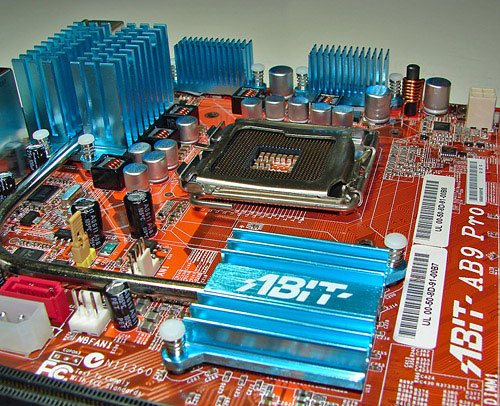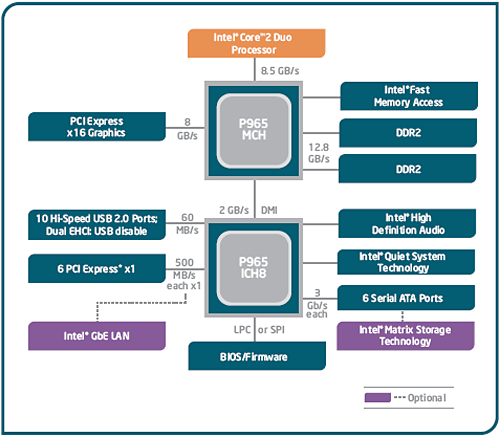Abit AB9 Pro: A sneak peek at Intel's new P965 chipset
by Gary Key on July 3, 2006 3:45 AM EST- Posted in
- Motherboards
As we mentioned in our Computex 2006 coverage, the rejuvenation of Abit was one of the more welcome surprises of the show. Abit was the top manufacturer of enthusiast level boards just a few short years ago and catered almost exclusively to the overclocking community. However, Abit found itself in serious trouble over the past couple of years as its product portfolio expanded to include video cards and a wide range of motherboards from the low end value segment to the upper end enthusiast sector. In essence, Abit tried to expand into areas where it did not have the manufacturing expertise or cost advantages to compete with the larger tier one manufacturers. As a result, Abit lost focus on its core competence, the enthusiast and overclocking market, and allowed DFI to become the number one brand name in an area where users are highly passionate about their products.

Toward the end of 2005, Abit was close to ceasing business operations as their product lines did not offer any real price, performance, or product differentiation from others except for their µGuru technology. Fortunately, Abit entered into a long-term partnership with USI this past January that ensures their financial health for the future and a change in the company name. Universal Abit is the successor to the Abit motherboard brand and has partnered with USI for their manufacturing and engineering expertise.
The Abit name will remain as the main identity for products but expect to hear more from Universal Abit as the company transitions itself from strictly IT manufacturing to leading technology design and brand management. This strategic partnership also signals a return of Abit to their roots as a company driven to provide the computer enthusiast and extreme overclocker with the highest performance solutions available. While we have not received their new Max or Fatal1ty product lines for review yet, Abit was generous enough to send us their mainstream Intel performance board -- the AB9 Pro -- based upon the new Intel P965 Express chipset.

Intel released the P965 Express MCH and ICH8/R chipsets during Computex 2006. While we will take a closer look at this new mainstream chipset in future articles, the highlights of the P965 MCH include Intel's new Fast Memory Access technology, 1066MHz front side bus support, 800MHz DDR-2 memory support, and full support for the new Core 2 Duo processor lineup. The integrated graphics versions, G965 and Q965, will ship with the new GMA X3000 graphics engine for the ViiV and Corporate markets respectively. The new ICH8/R chipsets offer ten USB 2.0 ports, up to six 3Gb/s SATA ports, Intel's new Quiet System Technology, and the removal of Parallel ATA support.
While one could argue that the removal of PATA support is a needed step forward in technology, we firmly believe that Intel should have waited until the next generation ICH for this change. The Optical Drive market is still about 98% PATA based and does not seem to be changing anytime soon. While this development might spur the optical drive suppliers into offering additional SATA drives in the near future, it does not address the requirements of the current PATA installed base. This most likely means there will be additional costs and complexity on the motherboards using ICH8 as the manufacturers will have to add an additional chipset for PATA support. (Manufacturers could simply choose not have any PATA ports, but at present we feel such a motherboard would be doomed to fail.)
Abit will be one of the first manufacturers to market with a P965 based board and we will take a quick but strictly preview look at the AB9 Pro today. While this motherboard is a production release unit, the BIOS is still undergoing almost daily revisions at this time. We will state at this point that our current BIOS release offers significant functionality, very good base performance, but will not yet allow us to change memory speeds or timings. Please keep this in mind as you compare the performance results against our Asus 975X based board. We will give this board a more in depth review during our forthcoming Intel Core 2 Duo motherboard roundup. Let's see what this board has to offer at this time.

Toward the end of 2005, Abit was close to ceasing business operations as their product lines did not offer any real price, performance, or product differentiation from others except for their µGuru technology. Fortunately, Abit entered into a long-term partnership with USI this past January that ensures their financial health for the future and a change in the company name. Universal Abit is the successor to the Abit motherboard brand and has partnered with USI for their manufacturing and engineering expertise.
The Abit name will remain as the main identity for products but expect to hear more from Universal Abit as the company transitions itself from strictly IT manufacturing to leading technology design and brand management. This strategic partnership also signals a return of Abit to their roots as a company driven to provide the computer enthusiast and extreme overclocker with the highest performance solutions available. While we have not received their new Max or Fatal1ty product lines for review yet, Abit was generous enough to send us their mainstream Intel performance board -- the AB9 Pro -- based upon the new Intel P965 Express chipset.

Intel released the P965 Express MCH and ICH8/R chipsets during Computex 2006. While we will take a closer look at this new mainstream chipset in future articles, the highlights of the P965 MCH include Intel's new Fast Memory Access technology, 1066MHz front side bus support, 800MHz DDR-2 memory support, and full support for the new Core 2 Duo processor lineup. The integrated graphics versions, G965 and Q965, will ship with the new GMA X3000 graphics engine for the ViiV and Corporate markets respectively. The new ICH8/R chipsets offer ten USB 2.0 ports, up to six 3Gb/s SATA ports, Intel's new Quiet System Technology, and the removal of Parallel ATA support.
While one could argue that the removal of PATA support is a needed step forward in technology, we firmly believe that Intel should have waited until the next generation ICH for this change. The Optical Drive market is still about 98% PATA based and does not seem to be changing anytime soon. While this development might spur the optical drive suppliers into offering additional SATA drives in the near future, it does not address the requirements of the current PATA installed base. This most likely means there will be additional costs and complexity on the motherboards using ICH8 as the manufacturers will have to add an additional chipset for PATA support. (Manufacturers could simply choose not have any PATA ports, but at present we feel such a motherboard would be doomed to fail.)
Abit will be one of the first manufacturers to market with a P965 based board and we will take a quick but strictly preview look at the AB9 Pro today. While this motherboard is a production release unit, the BIOS is still undergoing almost daily revisions at this time. We will state at this point that our current BIOS release offers significant functionality, very good base performance, but will not yet allow us to change memory speeds or timings. Please keep this in mind as you compare the performance results against our Asus 975X based board. We will give this board a more in depth review during our forthcoming Intel Core 2 Duo motherboard roundup. Let's see what this board has to offer at this time.










33 Comments
View All Comments
JarredWalton - Monday, July 3, 2006 - link
Corrected - the retail HSF was used, but it doesn't really matter since we didn't perform thorough overclocking, noise, or temperature testing yet. As mentioned in the article, we're waiting for a new BIOS release with memory timing adjustments before we do that.Heidfirst - Monday, July 3, 2006 - link
"This heatsink is part of the Abit Silent OTES technology that includes a heatpipe system and additional passive cooling for the VRM components. This system kept the MCH cool enough that additional chipset voltage was not a factor in our overclocking tests. Our only concern is the lifespan of the fanbut it is very quiet during operation"What fan?
JarredWalton - Monday, July 3, 2006 - link
Sorry - that was a fragment from an earlier article that slipped in. No fans. :)ALCX - Monday, July 3, 2006 - link
You didn't mention anything about how well this board overclocks! I would think with this 'stable' power and the D805 you would have an excellent opportunity. I'm also thinking getting a mboard like this with a $100 D805 and wait out Conroe supply issue/price until XMAS....ALCX
jones377 - Monday, July 3, 2006 - link
Do you have any plans to investigate I/O performance on this chipset? Those Winrar benches suggests these were vastly improved somehow. Memory latency/bandwidth benchmarks would be nice too. All compared to 975x, nvidia and ATI chipsets (for the Intel platform).mine - Saturday, July 8, 2006 - link
yes rightthis is what I am exspecting from anand in near future
if you like the info a little bit earlier
over@ xs
Chadder007 - Monday, July 3, 2006 - link
Im thinking about getting a motherboard like this and a Pentium D 805....and then waiting for the prices to go down and performance to go up for the Core 2's after maybe 1 year to upgrade.rqle - Monday, July 3, 2006 - link
I prefer a next gen board without the floopy, am still waiting. Keep PATA, well, third party chipset now, but kill off the floopy.Calin - Tuesday, July 4, 2006 - link
I'm all for it too - as long as you can install Windows on any computer without needing a floppy disk driveMacGuffin - Monday, July 3, 2006 - link
Or atleast X4 physical connectors, if X16 slots make things cramped for capacitors and other parts on the board. And what's up with this trend of 5/6 expansion slots on high-end motherboards? There was a time when most boards had 7 expansion slots. I guess the elaborate heatpipe mechanisms for 2-chip core logic interfere (eg. M2N-SLI vs. M2N32-SLI) with more expandability.
This is going to be a good year for technology!